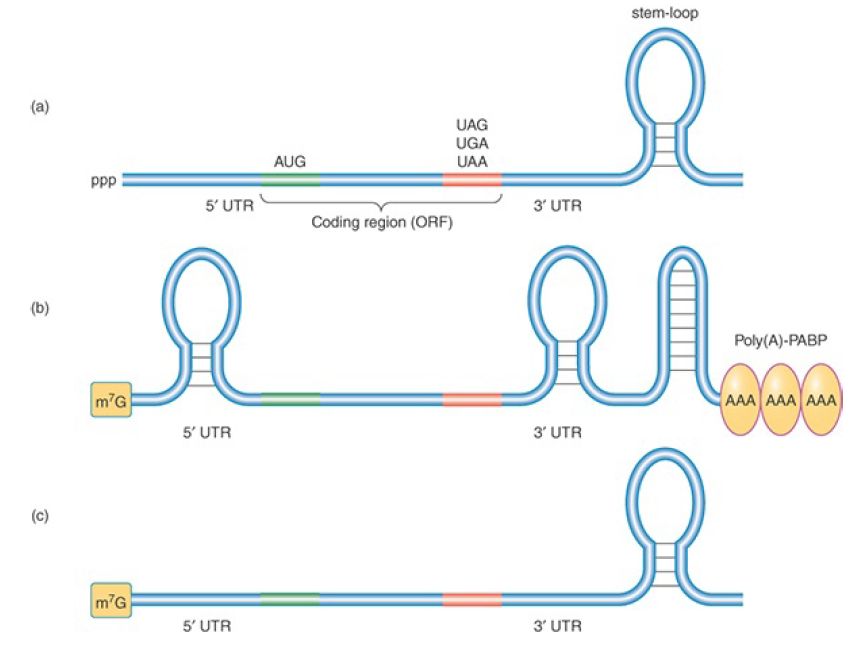


 النبات
النبات
 الحيوان
الحيوان
 الأحياء المجهرية
الأحياء المجهرية
 علم الأمراض
علم الأمراض
 التقانة الإحيائية
التقانة الإحيائية
 التقنية الحيوية المكروبية
التقنية الحيوية المكروبية
 التقنية الحياتية النانوية
التقنية الحياتية النانوية
 علم الأجنة
علم الأجنة
 الأحياء الجزيئي
الأحياء الجزيئي
 علم وظائف الأعضاء
علم وظائف الأعضاء
 الغدد
الغدد
 المضادات الحيوية
المضادات الحيوية|
Read More
Date: 31-10-2020
Date: 29-11-2015
Date: 17-5-2016
|
Introduction to mRNA Stability and Localization
RNA is critical at many stages of gene expression. The focus of this chapter is messenger RNA (mRNA), the first RNA to be characterized for its central role as an intermediate in protein synthesis. Many other RNAs play structural or functional roles at other stages of gene expression. The functions of other cellular RNAs are discussed in other chapters: snRNAs and snoRNAs in the chapter titled RNA Splicing and Processing; tRNA and rRNA in the chapter titled Translation; and miRNAs and siRNAs in the chapter titled Regulatory RNA.
Messenger RNA plays the principal role in the expression of protein-coding genes. Each mRNA molecule carries the genetic code for synthesis of a specific polypeptide during the process of translation. An mRNA carries much more information as well: how frequently it will be translated, how long it is likely to survive, and where in the cell it will be translated. This information is carried in the form of RNA cis-elements and associated proteins. Much of this information is located in parts of the mRNA sequence that are not directly involved in encoding protein.
FIGURE 1 shows some of the structural features typical of mRNAs in prokaryotes and eukaryotes. Bacterial mRNA termini are not modified after transcription, so they begin with the 5′ triphosphate nucleotide used in initiation of transcription and end with the final nucleotide added by RNA polymerase before termination. The 3′ end of many Escherichia coli mRNAs form a hairpin structure involved in intrinsic (rho-independent) transcription termination (see the chapter titled Prokaryotic Transcription).
Eukaryotic mRNAs are cotranscriptionally capped and polyadenylated . Most of the non-protein-coding regulatory information is carried in the 5′ and 3′ untranslated regions (UTRs) of an mRNA, but some elements are present in the coding region. All mRNAs are linear sequences of nucleotides, but secondary and tertiary structures can be formed by intramolecular base pairing.
These structures can be simple, like the stem-loop structures illustrated in Figure 20.1, or more complex, involving branched structures or pairing of nucleotides from distant regions of the molecule. Investigation of the mechanisms by which mRNA regulatory information is deciphered and acted upon by machinery responsible for mRNA degradation, translation, and localization is an important field in molecular biology today.

FIGURE .1 Features of prokaryotic and eukaryotic mRNAs. (a) A typical bacterial mRNA. This is a monocistronic mRNA, but bacterial mRNAs may also be polycistronic. Many bacterial mRNAs end in a terminal stem-loop. (b) All eukaryotic mRNAs begin with a cap (m G), and almost all end with a poly(A) tail. The poly(A) tail is coated with poly(A)-binding proteins (PABPs). Eukaryotic mRNAs may have one or more regions of secondary structure, typically in the 5′ and 3′ UTRs. (c) The major histone mRNAs in mammals have a 3′ terminal stem-loop in place of a poly(A) tail.



|
|
|
|
دراسة: إجراء واحد لتقليل المخاطر الجينية للوفاة المبكرة
|
|
|
|
|
|
|
"الملح والماء" يمهدان الطريق لأجهزة كمبيوتر تحاكي الدماغ البشري
|
|
|
|
|
|
بالصور: عند زيارته لمعهد نور الإمام الحسين (عليه السلام) للمكفوفين وضعاف البصر في كربلاء.. ممثل المرجعية العليا يقف على الخدمات المقدمة للطلبة والطالبات
|
|
|
|
ممثل المرجعية العليا يؤكد استعداد العتبة الحسينية لتبني إكمال الدراسة الجامعية لشريحة المكفوفين في العراق
|
|
|
|
ممثل المرجعية العليا يؤكد على ضرورة مواكبة التطورات العالمية واستقطاب الكفاءات العراقية لتقديم أفضل الخدمات للمواطنين
|
|
|
|
العتبة الحسينية تستملك قطعة أرض في العاصمة بغداد لإنشاء مستشفى لعلاج الأورام السرطانية ومركز تخصصي للتوحد
|